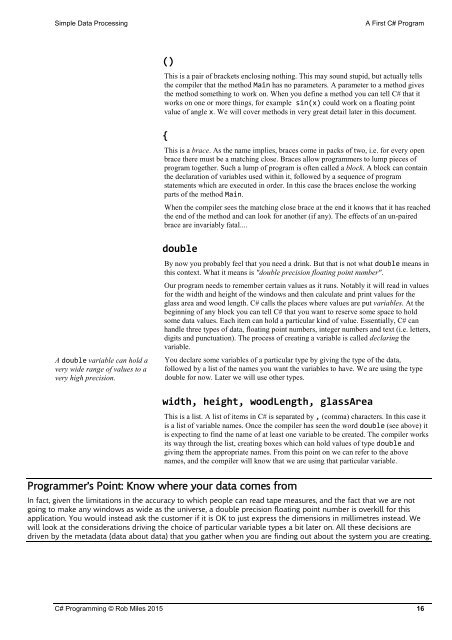C Programming Yellow Book
6019BjHWX
6019BjHWX
Create successful ePaper yourself
Turn your PDF publications into a flip-book with our unique Google optimized e-Paper software.
Simple Data Processing<br />
A First C# Program<br />
()<br />
This is a pair of brackets enclosing nothing. This may sound stupid, but actually tells<br />
the compiler that the method Main has no parameters. A parameter to a method gives<br />
the method something to work on. When you define a method you can tell C# that it<br />
works on one or more things, for example sin(x) could work on a floating point<br />
value of angle x. We will cover methods in very great detail later in this document.<br />
{<br />
This is a brace. As the name implies, braces come in packs of two, i.e. for every open<br />
brace there must be a matching close. Braces allow programmers to lump pieces of<br />
program together. Such a lump of program is often called a block. A block can contain<br />
the declaration of variables used within it, followed by a sequence of program<br />
statements which are executed in order. In this case the braces enclose the working<br />
parts of the method Main.<br />
When the compiler sees the matching close brace at the end it knows that it has reached<br />
the end of the method and can look for another (if any). The effects of an un-paired<br />
brace are invariably fatal....<br />
A double variable can hold a<br />
very wide range of values to a<br />
very high precision.<br />
double<br />
By now you probably feel that you need a drink. But that is not what double means in<br />
this context. What it means is "double precision floating point number".<br />
Our program needs to remember certain values as it runs. Notably it will read in values<br />
for the width and height of the windows and then calculate and print values for the<br />
glass area and wood length. C# calls the places where values are put variables. At the<br />
beginning of any block you can tell C# that you want to reserve some space to hold<br />
some data values. Each item can hold a particular kind of value. Essentially, C# can<br />
handle three types of data, floating point numbers, integer numbers and text (i.e. letters,<br />
digits and punctuation). The process of creating a variable is called declaring the<br />
variable.<br />
You declare some variables of a particular type by giving the type of the data,<br />
followed by a list of the names you want the variables to have. We are using the type<br />
double for now. Later we will use other types.<br />
width, height, woodLength, glassArea<br />
This is a list. A list of items in C# is separated by , (comma) characters. In this case it<br />
is a list of variable names. Once the compiler has seen the word double (see above) it<br />
is expecting to find the name of at least one variable to be created. The compiler works<br />
its way through the list, creating boxes which can hold values of type double and<br />
giving them the appropriate names. From this point on we can refer to the above<br />
names, and the compiler will know that we are using that particular variable.<br />
Programmer’s Point: Know where your data comes from<br />
In fact, given the limitations in the accuracy to which people can read tape measures, and the fact that we are not<br />
going to make any windows as wide as the universe, a double precision floating point number is overkill for this<br />
application. You would instead ask the customer if it is OK to just express the dimensions in millimetres instead. We<br />
will look at the considerations driving the choice of particular variable types a bit later on. All these decisions are<br />
driven by the metadata (data about data) that you gather when you are finding out about the system you are creating.<br />
C# <strong>Programming</strong> © Rob Miles 2015 16


